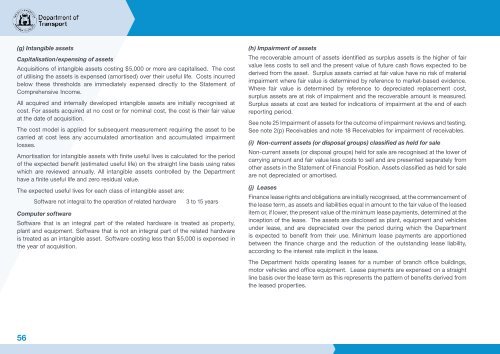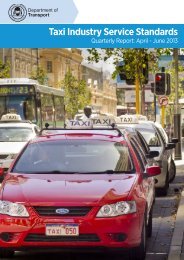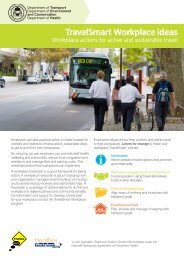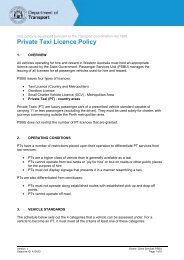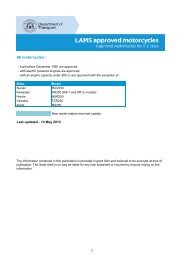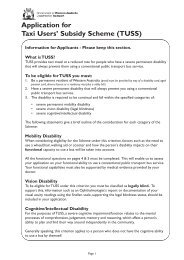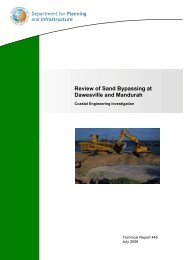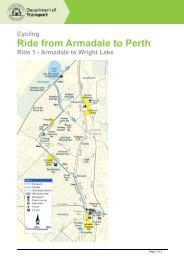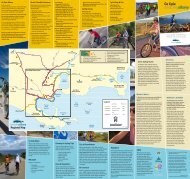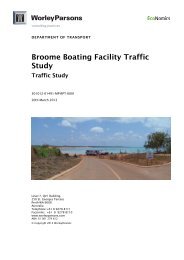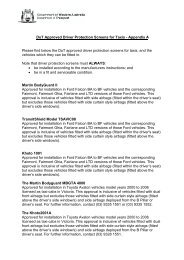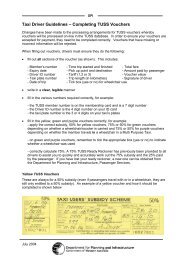Department of Transport Annual Report 2010 - 2011
Department of Transport Annual Report 2010 - 2011
Department of Transport Annual Report 2010 - 2011
Create successful ePaper yourself
Turn your PDF publications into a flip-book with our unique Google optimized e-Paper software.
(g) Intangible assets<br />
Capitalisation/expensing <strong>of</strong> assets<br />
Acquisitions <strong>of</strong> intangible assets costing $5,000 or more are capitalised. The cost<br />
<strong>of</strong> utilising the assets is expensed (amortised) over their useful life. Costs incurred<br />
below these thresholds are immediately expensed directly to the Statement <strong>of</strong><br />
Comprehensive Income.<br />
All acquired and internally developed intangible assets are initially recognised at<br />
cost. For assets acquired at no cost or for nominal cost, the cost is their fair value<br />
at the date <strong>of</strong> acquisition.<br />
The cost model is applied for subsequent measurement requiring the asset to be<br />
carried at cost less any accumulated amortisation and accumulated impairment<br />
losses.<br />
Amortisation for intangible assets with finite useful lives is calculated for the period<br />
<strong>of</strong> the expected benefit (estimated useful life) on the straight line basis using rates<br />
which are reviewed annually. All intangible assets controlled by the <strong>Department</strong><br />
have a finite useful life and zero residual value.<br />
The expected useful lives for each class <strong>of</strong> intangible asset are:<br />
56<br />
S<strong>of</strong>tware not integral to the operation <strong>of</strong> related hardware 3 to 15 years<br />
Computer s<strong>of</strong>tware<br />
S<strong>of</strong>tware that is an integral part <strong>of</strong> the related hardware is treated as property,<br />
plant and equipment. S<strong>of</strong>tware that is not an integral part <strong>of</strong> the related hardware<br />
is treated as an intangible asset. S<strong>of</strong>tware costing less than $5,000 is expensed in<br />
the year <strong>of</strong> acquisition.<br />
(h) Impairment <strong>of</strong> assets<br />
The recoverable amount <strong>of</strong> assets identified as surplus assets is the higher <strong>of</strong> fair<br />
value less costs to sell and the present value <strong>of</strong> future cash flows expected to be<br />
derived from the asset. Surplus assets carried at fair value have no risk <strong>of</strong> material<br />
impairment where fair value is determined by reference to market-based evidence.<br />
Where fair value is determined by reference to depreciated replacement cost,<br />
surplus assets are at risk <strong>of</strong> impairment and the recoverable amount is measured.<br />
Surplus assets at cost are tested for indications <strong>of</strong> impairment at the end <strong>of</strong> each<br />
reporting period.<br />
See note 25 Impairment <strong>of</strong> assets for the outcome <strong>of</strong> impairment reviews and testing.<br />
See note 2(p) Receivables and note 18 Receivables for impairment <strong>of</strong> receivables.<br />
(i) Non-current assets (or disposal groups) classified as held for sale<br />
Non-current assets (or disposal groups) held for sale are recognised at the lower <strong>of</strong><br />
carrying amount and fair value less costs to sell and are presented separately from<br />
other assets in the Statement <strong>of</strong> Financial Position. Assets classified as held for sale<br />
are not depreciated or amortised.<br />
(j) Leases<br />
Finance lease rights and obligations are initially recognised, at the commencement <strong>of</strong><br />
the lease term, as assets and liabilities equal in amount to the fair value <strong>of</strong> the leased<br />
item or, if lower, the present value <strong>of</strong> the minimum lease payments, determined at the<br />
inception <strong>of</strong> the lease. The assets are disclosed as plant, equipment and vehicles<br />
under lease, and are depreciated over the period during which the <strong>Department</strong><br />
is expected to benefit from their use. Minimum lease payments are apportioned<br />
between the finance charge and the reduction <strong>of</strong> the outstanding lease liability,<br />
according to the interest rate implicit in the lease.<br />
The <strong>Department</strong> holds operating leases for a number <strong>of</strong> branch <strong>of</strong>fice buildings,<br />
motor vehicles and <strong>of</strong>fice equipment. Lease payments are expensed on a straight<br />
line basis over the lease term as this represents the pattern <strong>of</strong> benefits derived from<br />
the leased properties.


